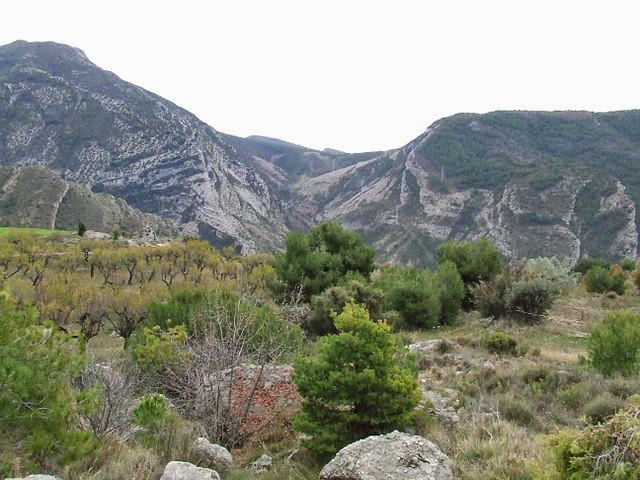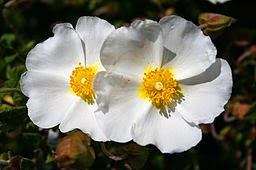By Helen Roberts
With the dismal wet wintry weather prevailing in the UK at this time of year, most people look forward to the return of warm long days, evenings outside and picnics on the beach. Things can look a little dreary and dull in people’s gardens at the moment, before the arrival of spring and its profusion of bulbs and other spring flowers. The Mediterranean collection at the University of Bristol Botanic Gardens helps to remind me of summer sun and balmy places.
Maquis: scrubland vegetation of the Mediterranean
 |
| Maquis shrubland in Conca de Dalt of Catalonia, northeastern Spain. Photo by Gustau Erill i Pinyot. Licensed under CC BY-SA 3.0 via Wikimedia Commons |
The Mediterranean Basin of Europe and North Africa display shows examples from different vegetation biomes; the collection includes evergreen forest, maquis or macchie and garique. Many of the highly aromatic and fragrant plants are associated with maquis vegetation. The maquis biome, which often includes leathery broadleaves, evergreen shrubs and small trees, usually occurs on the lower slopes of mountains bordering the Mediterranean Sea.
The climate of the maquis biome is characterised by long dry summers and short mild wet winters, with low annual rainfall. Ocean currents and fog influence the temperature and limit the growing season. The plants that grow here cope with the very hot summers by entering a slow growth period or dormant phase so they can resist long periods of drought.
Plant defences in this harsh environment are numerous. Many shrubs and low growing vegetation have thick tough leathery leaves, which reduce water loss but also deter hungry herbivores from grazing. Many plants contain volatile organic compounds (VOCs). These chemicals help facilitate interactions between plants and the environment – from attracting pollinators and seed dispensers to warding off pathogens, parasites and herbivores. When a plant is under attack from a herbivore, for example, it will release a chemical cocktail of VOCs, some of which have been found to attract natural predators of the herbivores. VOCs are also good at leaching into surrounding soil and so will deter the growth of other plants.
Plants containing VOCs are often very flammable, which is partly why areas of maquis are prone to wild fires.
Pyrophytes need a little fire in their lifecycle
 |
| Montpelier cistus (Cistus monspeliensis). Photo by Jean-Pol GRANDMONT via Wikimedia Commons |
Many of the plants in the maquis biomes are pyrophytes (fire loving plants) and require wild fires for reproduction, recycling of nutrients and removal of dead vegetation. Pyrophytes can be classed as active or passive. Active pyrophytes actually encourage fires as they often require fire in order to reproduce. Passive pyrophytes resist the effects of fires.
An active pyrophyte growing in the University of Bristol Botanic Garden maquis biome is Cistus monspeliensis, commonly known as the Montpelier cistus or rock rose. When a fire starts, Cistushas evolved to burn. This combustible conclusion to the adult plant helps destroy competing plants near to it. However, unlike its competitors, the fire will mechanically rupture the seeds of Cistus and the smoke and heat will trigger germination of the next generation. The Cistus seedlings have the advantage of beginning life in a competitor-free environment.
 |
| A closed cone and foliage of Pinus pinea. Licensed under CC BY-SA 2.5 es via Wikimedia Commons |
Pinus pinea (the stone pine) is also in the Botanic Garden’s collection and it is a passive pyrophyte. It has a thick bark with high moisture content to help it resist fire. Its hard-coated fire resistant cones open when exposed to high temperatures. This is particularly useful in the harvest of the desirable seeds, known to many of us as pine nuts. As the tree grows, it self-prunes the lower branches, which helps prevent the fire travelling at ground level from jumping up into the canopy and potentially destroying the tree.
Some species spring back from fire events by sprouting new growth from the old. There are two such sprouter species in the Botanic Garden’s collection. The carob tree (Ceratonia siliqua) re-sprouts from epicormicbuds that lie dormant beneath the bark. These buds are normally suppressed by hormones produced by active shoots, but after a fire event and the destruction of the foliage, the buds are activated. Erica arborea (tree heath) re-sprouts from root crowns so is known as a below ground sprouter. It produces seed in the first post-fire summer.
Fire adapted plants of the maquis biome are only a handful of those plants making up the Garden’s Mediterranean collection. The collection also includes plants (some of which are also pyrophytes) from the southwestern tip of South Africa and displays are also under development from the Western andSouthern Australian, Chilean and Californian Mediterranean climate regions.
The half hardy plants of the Mediterranean collection are planted out in each respective biome in the summer, whilst more tender plants are protected from our cooler Bristol temperatures in the warm temperate and cool zones of the glasshouses. The outdoor collection sits on a south facing rocky bank to maximise the amount of sun and aid drainage. The path meanders through the collection allowing visitors to appreciate the appearance and fragrances of the different plants. These are all good things to look forward to in the summer months, but meanwhile if you have the chance to warm yourself in front of a crackling fire, think of those volatile fire-loving plants!



